�
Enumerative Combinatorics
This is the second of a two-volume basic introduction to enumerative combinatorics
at a level suitable for graduate students and research mathematicians.
This volume covers the composition of generating functions, trees, algebraic
generating functions, D-finite generating functions, noncommutative generating
functions, and symmetric functions. The chapter on symmetric functions provides
the only available treatment of this subject suitable for an introductory graduate
course and focusing on combinatorics, especially the Robinson-Schensted-Knuth
algorithm. Also covered are connections between symmetric functions and rep-
resentation theory. An appendix (written by Sergey Fomin) covers some deeper
aspects of symmetric function theory, including jeu de taquin and the Littlewood-
Richardson rule.
As in Volume 1, the exercises play a vital role in developing the material. There
are over 250 exercises, all with solutions or references to solutions, many of which
concern previously unpublished results.
Graduate students and research mathematicians who wish to apply combina-
torics to their work will find this an authoritative reference.
Richard P. Stanley is Professor of Applied Mathematics at the Massachusetts
Institute of Technology. He has held visiting positions at UCSD, the University of
Strasbourg, California Institute of Technology, the University of Augsburg, Tokai
University, and the Royal Institute of Technology in Stockholm. He has published
over 100 research papers in algebraic combinatorics. In addition to the two-volume
Enumerative Combinatorics, he has published one other book, Combinatorics and
Commutative Algebra (Birkhauser; second edition, 1997). He is a fellow of the
American Academy of Arts and Sciences, a member of the National Academy of
Sciences, and a recipient of the Pblya Prize in Applied Combinatorics awarded by
the Society for Industrial and Applied Mathematics.
CAMBRIDGE STUDIES IN ADVANCED MATHEMATICS 62
Already published
J.L. Alperin Local representation theory
Introduction to harmonic analysis on semisimple Lie groups
P. Koosis The logarithmic integral !!
J.F. Humphreys Reflection groups and Coxeter groups
J.-P. Kahane Some random series of functions, 2nd edition
J. Lambek & P.J. Scott
Introduction to higher-order categorical logic
P. Wojtaszczyk Banach spaces for analysts
J.E. Gilbert & M.A.M. Murray Clifford algebras and Dirac operators in harmonic analysis
2 K. Petersen Ergodic theory
P.T. Johnstone Stone spaces
3
4 W.H. Schikhof Ultrametric calculus
5
7
8 H. Matsumura Commutative ring theory
9 C.B. Thomas Characteristic classes and the cohomology of finite groups
10 M. Aschbacher Finite group theory
11
12 P. Koosis The logarithmic integral I
13 A. Pietsch Eigenvalues and s-numbers
14 S.J. Patterson An introduction to the theory of the Riemann zeta-function
15 H.J. Baues Algebraic homotopy
16 V.S. Varadarajan
17 W. Dicks & M. Dunwoody Groups acting on graphs
18 L.J. Corwin & F.P. Greenleaf Representations of nilpotent Lie groups and their applications
19 R. Fritsch & R. Piccinini Cellular structures in topology
20 H. Klingen Introductory lectures on Siegel modular forms
21
22 M.J. Collins Representations and characters of finite groups
24 H. Kunita Stochastic flows and stochastic differential equations
25
26
27 A. Frohlich & M.J. Taylor Algebraic number theory
28 K. Goebel & W.A. Kirk Topics in metric fixed point theory
29
30 D.J. Benson Representations and cohomology I
31 D.J. Benson Representations and cohomology II
32 C. Allday & V. Puppe Cohomological methods in transformation groups
33 C. Soule et al. Lectures on Arakelov geometry
34 A. Ambrosetti & G. Prodi A primer of nonlinear analysis
35
37 Y. Meyer Wavelets and operators 1
38 C. Weibel An Introduction to homological algebra
39 W. Bruns & J. Herzog Cohen-Macaulay rings
40 V. Snaith Explicit Brauer induction
41 G. Laumon Cohomology of Drinfeld modular varieties: Part I
42 E.B. Davies Spectral theory and differential operators
43
44 P. Mattila Geometry of sets and measures in Euclidean spaces
45 R. Pinsky Positive harmonic functions and diffusion
46 G. Ienenbaum Introduction to analytic and probabilistic number theory
47 C. Peskine Complex projective geometry
48 Y. Meyer & R. Coifman Wavelets
49 R. Stanley Enumerative combinatorics I
50
51 M. Audin
52 V. Jurdjevic Geometric control theory
53 H. Volklein Groups as Galois groups
54
55 D. Bump Automorphic forms and representations
56 G. Laumon Cohomology of Drinfeld modular varieties II
60 M.P. Brodmann & R.Y. Sharp Local cohomology
J. Palis & F. Takens Hyperbolicity, stability and chaos at homoclinic bifurcations
J. Diestel, H. Jarchow & A. Tonge Absolutely summing operators
I. Porteous Clifford algebras and the classical groups
Spinning tops
J. Le Potier Lectures on vector bundles
�
ENUMERATIVE COMBINATORICS
Volume 2
RICHARD P. STANLEY
Massachusetts Institute of Technology
AMBRIDGE
UNIVERSITY PRESS
�
PUBLISHED BY THE PRESS SYNDICATE OF THE UNIVERSITY OF CAMBRIDGE
The Pitt Building, Trumpington Street, Cambridge, United Kingdom
CAMBRIDGE UNIVERSITY PRESS
The Edinburgh Building, Cambridge CB2 2RU, UK
40 West 20th Street, New York, NY 10011-4211, USA
10 Stamford Road, Oakleigh, Melbourne 3166, Australia
Ruiz de Alarcon 13, 28014 Madrid, Spain
Dock House, The Waterfront, Cape Town 8001, South Africa
http://www.cambridge.org
© Cambridge University Press 1999
This book is in copyright. Subject to statutory exception
and to the provisions of relevant collective licensing agreements,
no reproduction of any part may take place without
the written permission of Cambridge University Press.
First published 1999
First paperback edition 2001
Typeset in Times Roman 10/12 pt. in I9TEX 2E [TB]
A catalog record for this book is available from the British Library
Library of Congress Cataloging in Publication data is available
ISBN 0 521 56069 1 hardback
ISBN 0 521 78987 7 paperback
Transferred to digital printing 2004
�
Foreword
Most textbooks written in our day have a short half-life. Published to meet the
demands of a lucrative but volatile market, inspired by the table of contents of
some out-of-print classic, garnished with multicolored tables, enhanced by nut-
shell summaries, enriched by exercises of dubious applicability, they decorate the
shelves of college bookstores come September. The leftovers after Registration
Day will be shredded by Christmas, unwanted even by remainder bookstores. The
pageant is repeated every year, with new textbooks on the same shelves by other
authors (or a new edition if the author is the same), as similar to the preceding as
one can make them, short of running into copyright problems.
Every once in a long while, a textbook worthy of the name comes along; invari-
ably, it is likely to prove aere perennius: Weber, Bertini, van der Waerden, Feller,
Dunford and Schwartz, Ahlfors, Stanley.
The mathematical community professes a snobbish distaste for expository writ-
ing, but the facts are at variance with the words. In actual reality, the names of
authors of the handful of successful textbooks written in this century are included
in the list of the most celebrated mathematicians of our time.
Only another textbook writer knows the pains and the endless effort that goes
into this kind of writing. The amount of time that goes into drafting a satisfactory
exposition is always underestimated by the reader. The time required to complete
one single chapter exceeds the time required to publish a research paper. But far
from wasting his or her time, the author of a successful textbook will be amply
rewarded by a renown that will spill into the distant future. History is more likely
to remember the name of the author of a definitive exposition than the names of
many a research mathematician.
I find it impossible to predict when Richard Stanley's two-volume exposition
of combinatorics may be superseded. No one will dare try, let alone be able, to
match the thoroughness of coverage, the care for detail, the definitiveness of proof,
the elegance of presentation. Stanley's book possesses that rarest quality among
textbooks: you can open it at any page and start reading with interest without
having to hark back to page one for previous explanations.
v
�
vi
Foreword
Combinatorics, which only thirty years ago was a fledgling among giants, may
well be turning out to be a greater giant, thanks largely to Richard Stanley's
work. Every one who deals with discrete mathematics, from category theorists to
molecular biologists, owes him a large debt of gratitude.
Gian-Carlo Rota
March 21, 1998
�
Preface
This is the second (and final) volume of a graduate-level introduction to enu-
merative combinatorics. To those who have been waiting twelve years since the
publication of Volume 1, I can only say that no one is more pleased to see Volume
2 finally completed than myself. I have tried to cover what I feel are the fundamen-
tal topics in enumerative combinatorics, and the ones that are the most useful in
applications outside of combinatorics. Though the book is primarily intended to be
a textbook for graduate students and a resource for professional mathematicians, I
hope that undergraduates and even bright high-school students will find something
of interest. For instance, many of the 66 combinatorial interpretations of Catalan
numbers provided by Exercise 6.19 should be accessible to undergraduates with a
little knowledge of combinatorics.
Much of the material in this book has never appeared before in textbook form.
This is especially true of the treatment of symmetric functions in Chapter 7. Al-
though the theory of symmetric functions and its connections with combinatorics
is in my opinion one of the most beautiful topics in all of mathematics, it is a
difficult subject for beginners to learn. The superb book by Macdonald on sym-
metric functions is highly algebraic and eschews the fundamental combinatorial
tool in this subject, viz., the Robinson-Schensted-Knuth algorithm. I hope that
Chapter 7 adequately fills this gap in the mathematical literature. Chapter 7 should
be regarded as only an introduction to the theory of symmetric functions, and not
as a comprehensive treatment.
As in Volume 1, the exercises play a vital role in developing the subject. If in
reading the text the reader is left with the feeling of "what's it good for?" and is
not satisfied with the applications presented there, then (s)he should turn to the
exercises. Thanks to the wonders of electronic word processing, I found it much
easier than for Volume 1 to assemble a wide variety of exercises and solutions.
I am grateful to the many persons who have contributed in a number of ways
to the improvement of this book. Special thanks go to Sergey Fomin for his many
suggestions related to Chapter 7, and especially for his masterful exposition of
the difficult material of Appendix 1. Other persons who have carefully read por-
tions of earlier versions of the book and who have offered valuable suggestions
vii
�
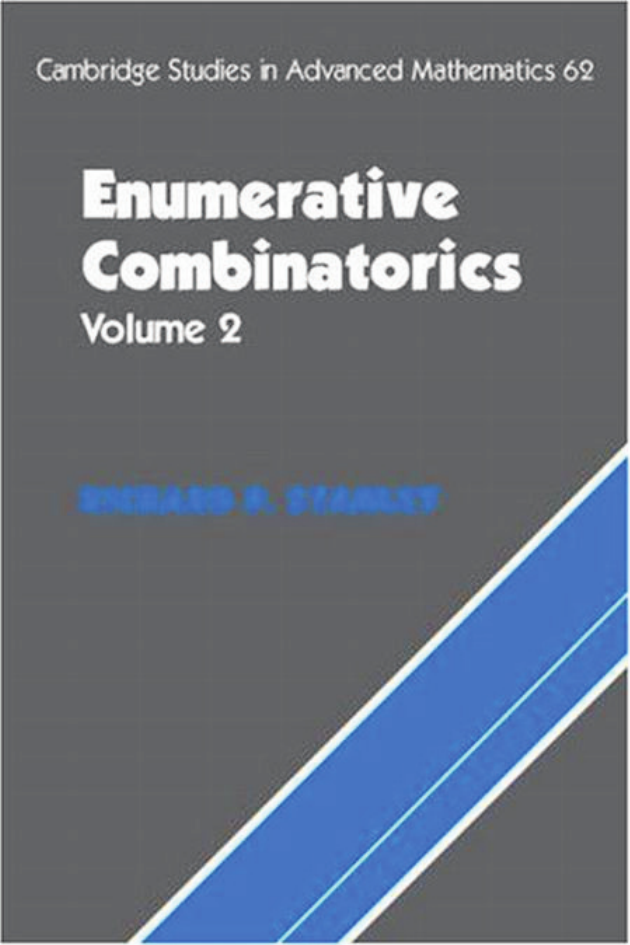
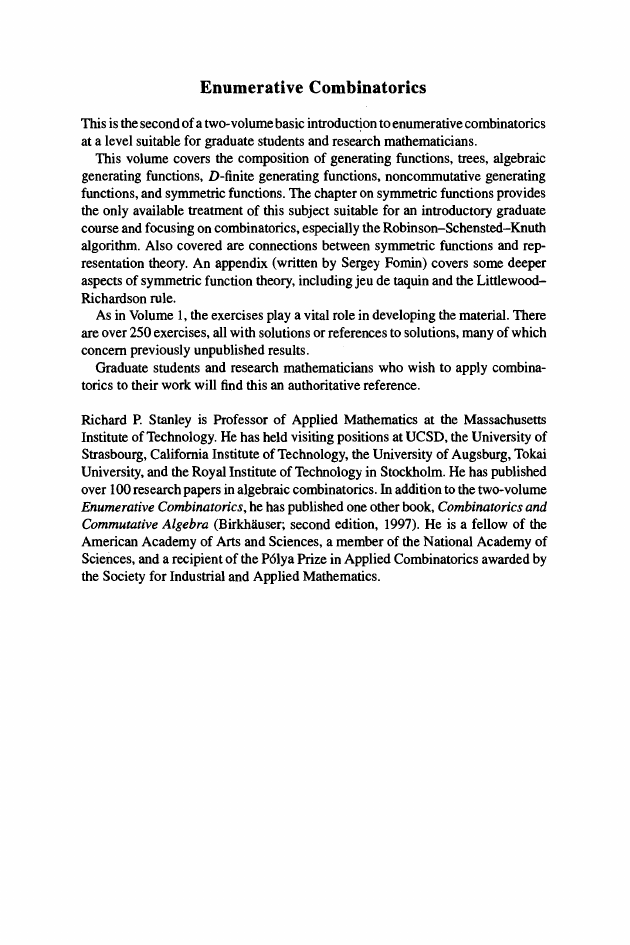
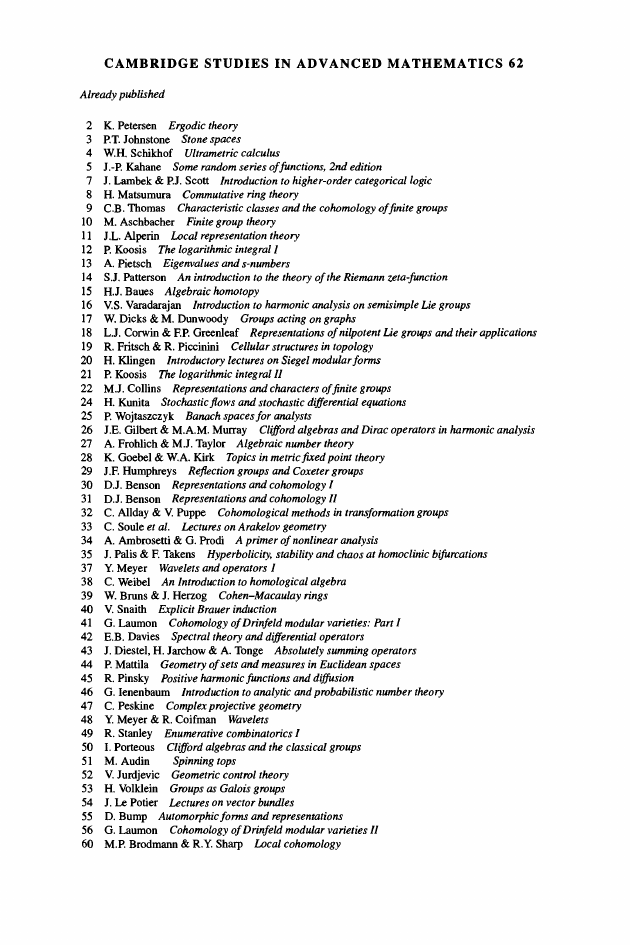
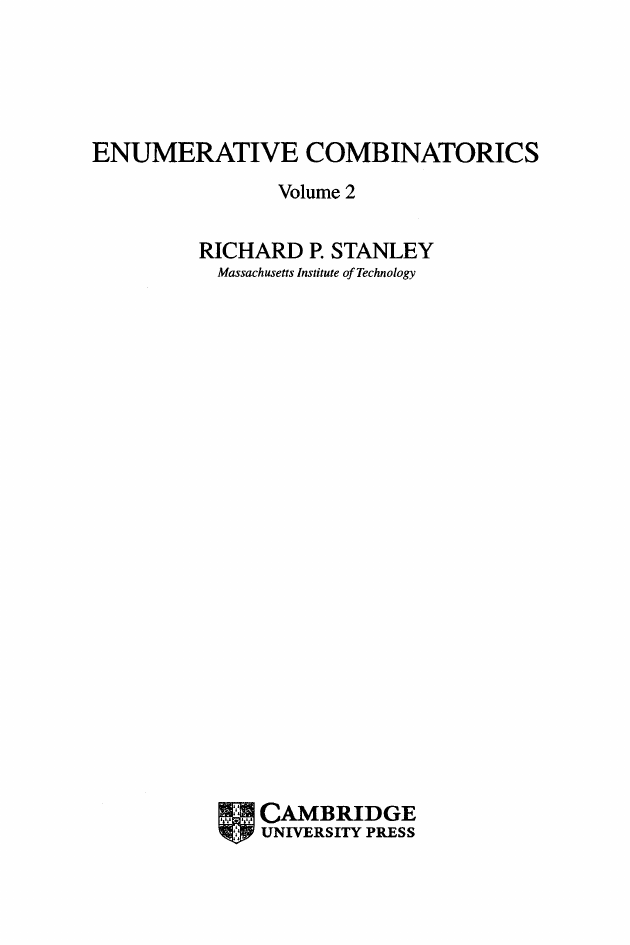
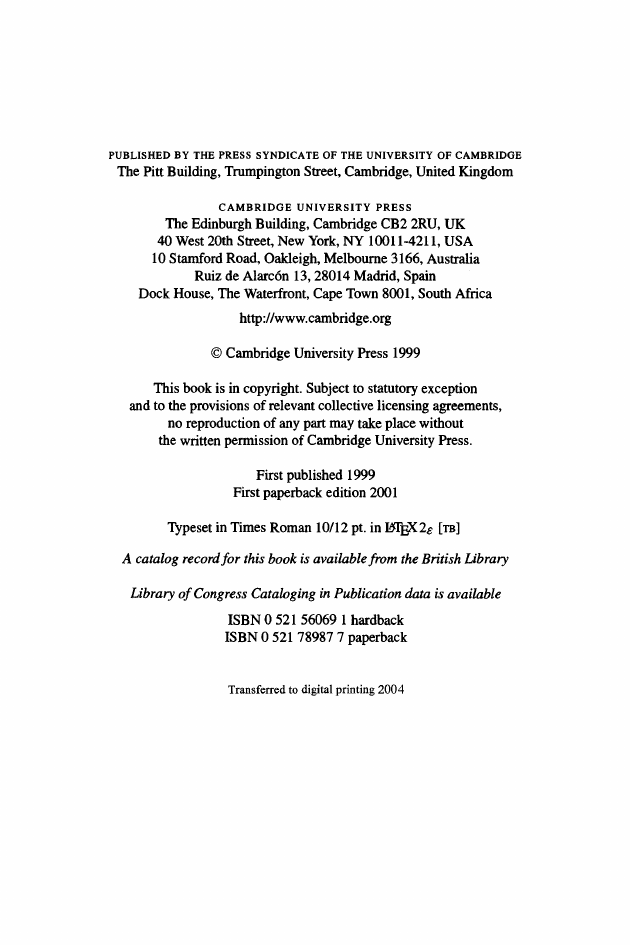
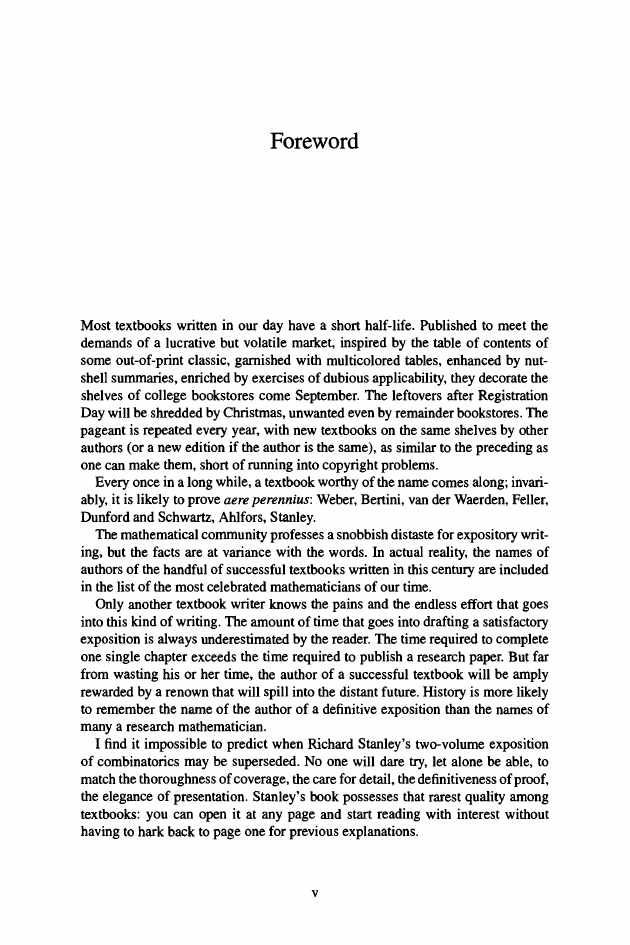

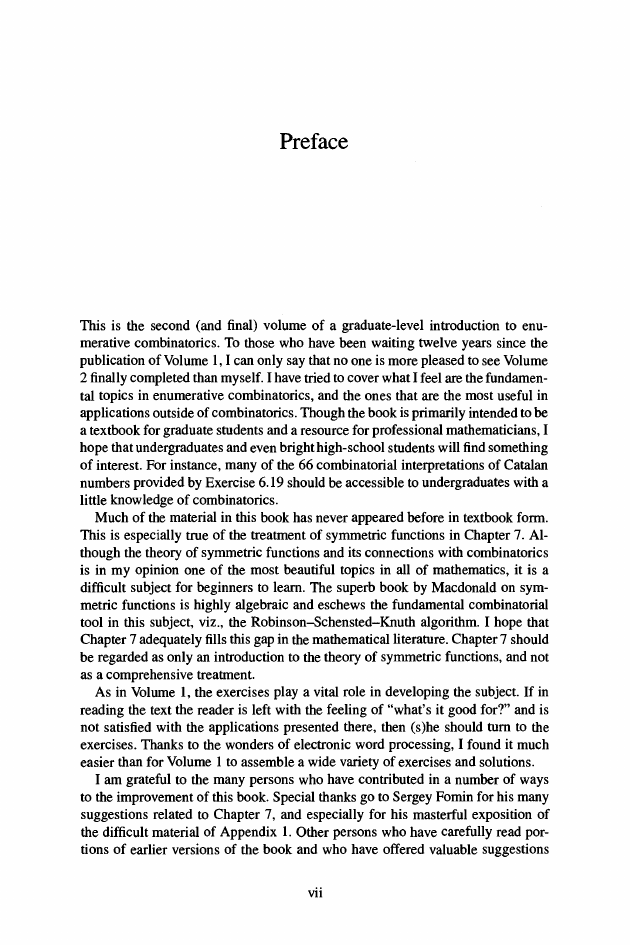








 2023年江西萍乡中考道德与法治真题及答案.doc
2023年江西萍乡中考道德与法治真题及答案.doc 2012年重庆南川中考生物真题及答案.doc
2012年重庆南川中考生物真题及答案.doc 2013年江西师范大学地理学综合及文艺理论基础考研真题.doc
2013年江西师范大学地理学综合及文艺理论基础考研真题.doc 2020年四川甘孜小升初语文真题及答案I卷.doc
2020年四川甘孜小升初语文真题及答案I卷.doc 2020年注册岩土工程师专业基础考试真题及答案.doc
2020年注册岩土工程师专业基础考试真题及答案.doc 2023-2024学年福建省厦门市九年级上学期数学月考试题及答案.doc
2023-2024学年福建省厦门市九年级上学期数学月考试题及答案.doc 2021-2022学年辽宁省沈阳市大东区九年级上学期语文期末试题及答案.doc
2021-2022学年辽宁省沈阳市大东区九年级上学期语文期末试题及答案.doc 2022-2023学年北京东城区初三第一学期物理期末试卷及答案.doc
2022-2023学年北京东城区初三第一学期物理期末试卷及答案.doc 2018上半年江西教师资格初中地理学科知识与教学能力真题及答案.doc
2018上半年江西教师资格初中地理学科知识与教学能力真题及答案.doc 2012年河北国家公务员申论考试真题及答案-省级.doc
2012年河北国家公务员申论考试真题及答案-省级.doc 2020-2021学年江苏省扬州市江都区邵樊片九年级上学期数学第一次质量检测试题及答案.doc
2020-2021学年江苏省扬州市江都区邵樊片九年级上学期数学第一次质量检测试题及答案.doc 2022下半年黑龙江教师资格证中学综合素质真题及答案.doc
2022下半年黑龙江教师资格证中学综合素质真题及答案.doc